Thermodynamic Properties and Anharmonic Effects in XAFS Based on Anharmonic Correlated Debye Model Debye–Waller Factors
Abstract
Thermodynamic properties and anharmonic effects in X-ray absorption fine structure (XAFS) have been studied based on the anharmonic correlated Debye model Debye–Waller factors presented in terms of cumulant expansion. The derived analytical expressions of three first XAFS cumulants involve more information on phonon-phonon interactions taken from integration over the first Brillouin zone. Many-body effects are taken into account in the present one-dimensional model based on the first shell near neighbor contributions to the vibrations between absorber and backscatterer atoms. Morse potential is assumed to describe single-pair atomic interaction included in the derived anharmonic interatomic effective potential. The present theory can be applied to any crystal structure including complex systems. Numerical results for Cu and Ni are found to be in good agreement with experiment and with those of the other theories.
1. Introduction
X-ray absorption fine structure (XAFS) has developed into a powerful probe of atomic structure, thermodynamic properties, and anharmonic effects in atomic vibration of substances [1–28]. Thermal atomic vibrations and disorder give rise to Debye–Waller factors (DWFs) in XAFS describing these properties of the considered material. The formalism for including anharmonic effects in XAFS is often based on cumulant expansion [1] where the even cumulants contribute to the amplitude and the odd ones to the phase of XAFS spectra. Hence, the accurate DWFs presented in terms of cumulant expansion are crucial to quantitative treatment of anharmonic XAFS. Consequently, the lack of the precise DWFs or cumulants has been one of the biggest limitations to accurate structural determinations, thermodynamic properties, and anharmonic effects in atomic vibration of materials taken from XAFS experiments. Therefore, a reliable and effective method for treatment of thermal and structural disorders based on DWFs still represents an open problem, whose solution is expected to increase the amount and accuracy of information obtainable from XAFS.
Many efforts have been made to derive procedures for the calculation and analysis of cumulants describing the thermodynamic properties and anharmonic effects or phonon-phonon interactions in temperature-dependent XAFS [2–28] using the classical approach [3–6] and quantum theory [7–28]. Classical theories have the advantages shown by simplicity and possibility of application to high temperatures where anharmonicity is dominant, and quantum methods can be applied to both high and low temperatures where quantum effects are evident. The anharmonic correlated Einstein model (ACEM) [9] has been derived for the calculation and analysis of DWFs presented in terms of cumulant expansion up to the third order. Its simplicity and efficiency in XAFS studies is demonstrated by calculating and analyzing XAFS cumulants of fcc [9–13], hcp [14], and crystals and in studying pressure-dependent XAFS [15]. The statistical moment method [16, 17] has been applied to calculate the mean square relative displacement (MSRD) including anharmonic contributions of some crystals. The derived path-integral effective potential (PIEP) method [18] has the advantage for calculating XAFS DWFs presented in terms of cumulant expansion up to the fourth order based on quantum theory including three dimension, correlation, anharmonicity, and many-body effects. The other efforts in XAFS cumulant studies have been shown, for example, by the path-integral Monte Carlo (PIMC) calculations [19], the force constant method (FCM) [20], and the local density approximation (LDA) [21] based on the density functional theory calculations of dynamic matrix.
The purpose of this work is XAFS study of the thermodynamic properties and anharmonic effects of materials based on the anharmonic correlated Debye model (ACDM) DWFs presented in terms of cumulant expansion up to the third order. In Section 2, the analytical expressions for the dispersion relation, correlated Debye frequency and temperature, and three first XAFS cumulants have been derived. They involve more information of phonon-phonon interactions taken from integration over the first Brillouin zone (BZ). The many-body effects are taken into account in the present one-dimensional model based on the first shell near neighbor contributions to the vibrations between absorber and backscatterer atoms. Morse potential is assumed to describe the single-pair atomic interaction included in the derived anharmonic interatomic effective potential. The thermodynamic properties and anharmonic effects in atomic vibration have been analyzed based on the obtained temperature-dependent XAFS cumulants where the anharmonicity causing thermal expansion and the MSRD component perpendicular to bond direction have been discussed in detail. This theory can be applied to any crystal structure including complex systems. Numerical results for Cu and Ni presented in Section 3 are compared to a large number of experimental data [13, 19–26] and to those calculated using several well-known methods such as ACEM [9], SMM [16], PIEP [18], PIMC [19], FCM [20], and LDA [21] at lowand high temperatures to show the advantage of the present theory. The conclusions on the obtained results are presented in Section 4 of the paper.
2. Formalism
2.1. Anharmonic Effective Potential
Note that the lattice contributions to the oscillation between absorber and backscatterer atoms illustrated by the second term of (2) can be obtained using the first shell near neighbors contributions approach (FSNNCA), which has been successfully applied to bcc crystals [28]. Hence, based on the first shell near neighbor contributions to the vibration between absorber and backscatterer, the many-body effects have been taken into account in the present one-dimensional model.
Applying Morse potential (3) to (2) and comparing the results to (1), the values of keff and k3eff of the anharmonic effective potential presented in terms of Morse potential parameters are determined.
2.2. XAFS Cumulants Based on ACDM
Derivation of the present ACDM is performed using the many-body perturbation approach (MBPA) [29] based on the dualism of an elementary particle in quantum theory, that is, its corpuscular and wave property. Then, we can describe the system in the present ACDM involving all different frequencies up to the Debye frequency as a system consisting of many bodies, that is, many phonons, each of which corresponds to a wave having frequency ω(q) and wave number q varied in the first BZ. Moreover, based on the FSNNCA only backscattering from the first shell of absorber and backscatterer atoms is taken into consideration. This reduces and simplifies the derivations of the analytical expressions of the considered XAFS cumulants.
In the above expressions for the cumulants in the present ACDM, are zero-point energy contributions to the first, second, and third cumulant, respectively, and these cumulant expressions have been obtained for the case of large phonon numbers, when the summation over q is replaced by the corresponding integral in the first BZ. Moreover, we have used the phonon momentum conservation in the first BZ [30] to describe the value of q3 by q1 and q2 for the first and third cumulant. This leads to reducing the integrations for these cumulants given by (22) and (25), respectively.
Note that the present theory is valid for any crystal structure including complex systems; therefore, the other developments for the monatomic [27] and bcc [28] crystals are only its special cases.
2.3. High- and Low-Temperature Limits of XAFS Cumulants
| Cumulant | T → 0 | T → ∞ |
|---|---|---|
| σ(1) | ||
| σ2 | kBT/keff | |
| σ(3) | ||
| σ(1)σ2/σ(3) | — | 1/2 |
Note from Table 1 that at high temperatures, the first and second cumulants are proportional to the temperature T, the third cumulant to T2 as the standard characters for these quantities as it was mentioned in the other theories [7–9]. At low temperatures, they approach their zero-point energy contributions which also involve contributions of q-values from the first BZ. Moreover, at high temperature, the cumulant ratio σ(1)σ2/σ(3) approaches the classical value of 1/2 [5, 6].
3. Numerical Results and Discussions
Now the expressions derived in the previous section are applied to numerical calculations for Cu and Ni in fcc phase using their Morse potential parameters [31] D = 0.3429 eV, α = 1.3588 Å−1 for Cu and D = 0.4205 eV, α = 1.4199 Å−1 for Ni, which were obtained using experimental values for the energy of sublimation, the compressibility, and the lattice constant. The values of local force constant keff, correlated Debye frequency ωD, and temperature θD calculated using the present theory are given in Table 2. They are found to be in good and reasonable agreement with the experimental values [23, 25], where the experimental values of [23] have been calculated from its measured Morse potential parameters [23] as an extraction method which was used elsewhere [13].
Thermodynamic properties and anharmonic effects of materials depend on the atomic interactions described by the anharmonic interatomic effective potentials Veff presented in Figure 1. The present ACDM includes dispersion relations ω(q) (Figure 2) to involve contributions of all atomic vibration frequencies. Their values for Cu and Ni calculated using the present theory are shown in good agreement with experiment taken from the measured Morse potential parameters [23]. The anharmonic effective potentials are asymmetric causing the anharmonic shifting, and the correlated frequencies approach the values of Debye frequencies (Table 2) at the bounds of the first BZ, q = ±π/a.
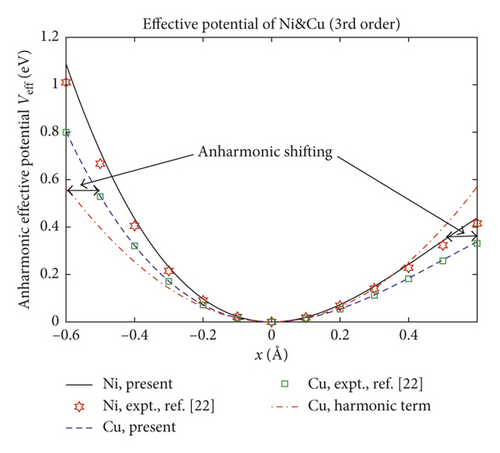

Figure 3 shows good agreement of temperature dependence of first cumulant σ(1)(T) of Cu and Ni calculated using the present theory with the experimental values (Expt.) [13, 19, 23] for Cu and [23] for Ni. Moreover, the results for Cu agree well with those calculated using the ACEM [9]. Note that, using the first cumulant, we can obtain temperature dependence of the first shell near neighbor distance based on the expression R(T) = R(0) + σ(1)(T).
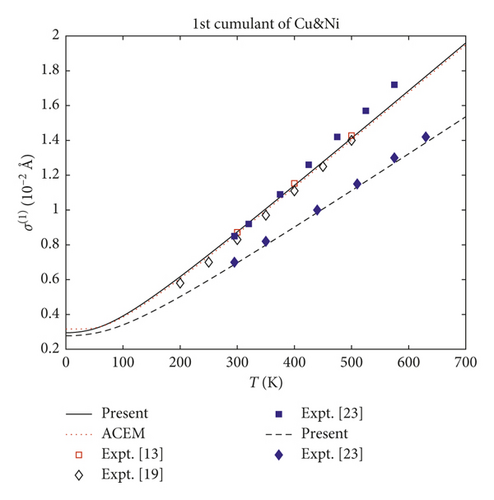
Temperature dependence of second cumulant σ2(T) (Figure 4) of Cu and Ni calculated using the present theory agrees well with the experimental values Expt. [13, 22, 23, 25] for Cu and [23] for Ni, as well as with those calculated using the ACEM [9]. Here, the present result is also compared to those calculated using the SMM [16], FCM [20], and LDA [21] for Cu and PIEP [18] for Ni, which are found to be in reasonable agreement with the experiment.
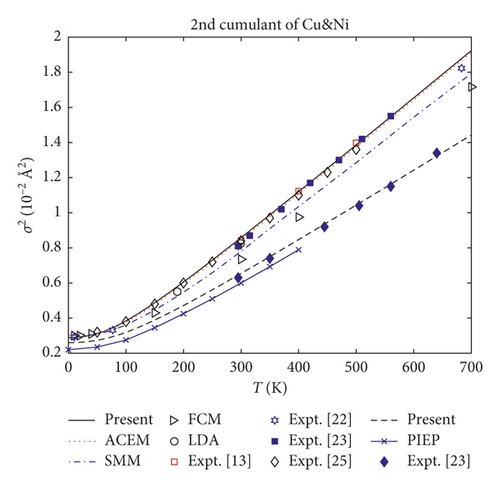
Figure 5 shows good agreement of temperature dependence of third cumulant σ(3)(T) of Cu and Ni calculated using the present theory with the experimental values Expt. [13, 23, 24, 26] for Cu and [23] for Ni. These results are also found to be in good agreement with those calculated using the ACEM [9] and the PIMC [19] for Cu.
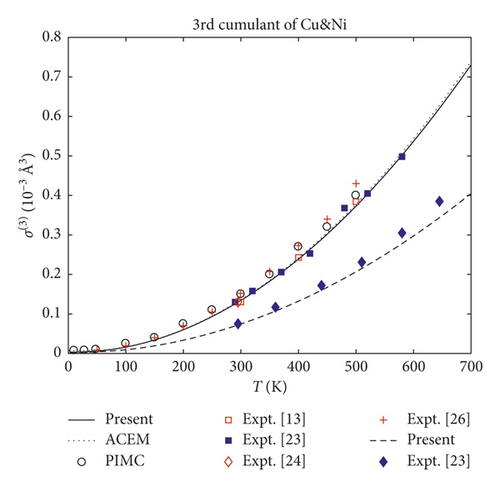
The cumulant ratio σ(1)σ2/σ(3) is often considered as a standard for cumulant studies to identify the temperature above which the classical limit is applicable [9–14]. Figure 6 shows that in the present ACDM this temperature is the Debye temperature (θD = 334 K for Cu and 376 K for Ni) while such temperature for ACEM is the Einstein temperature [9] because from this temperature the ratio reaches the classical value of 1/2 [9, 10, 14] and classical limit is applicable. Here, the result for Cu agrees well with the experimental values at 300 K, 400 K, and 500 K [13].
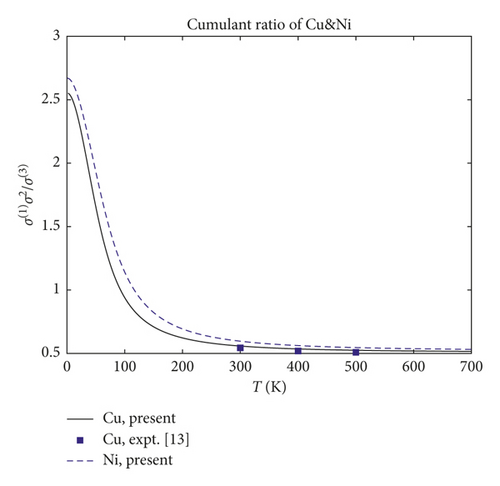
Anharmonicity is the result of phonon-phonon interaction and gives rise to thermal expansion shown in temperature-dependent XAFS of materials. The anharmonic effects in XAFS have been detected quite early [32]. After the first pioneering studies on AgI [33] and CuBr [2], it has been shown that anharmonicity cannot be neglected in XAFS studies of thermodynamic properties and structural determination of materials [2–28]. The XAFS cumulants parametrize the asymmetric distribution of interatomic distances and can be connected to the force constants of a one-dimensional effective pair potential [5, 9–15, 34]. In particular, the first three cumulants measure the average value, the variance, and the asymmetry of the distribution, respectively [25]. Both the first and third cumulants have often been considered equally sensitive to thermal expansion [35]. This equivalence, which is valid for a one-dimensional system, where the average distance is solely modified by the asymmetry of the interaction potential, was not confirmed by accurate XAFS measurements of nearest neighbors’ distances in several simple crystals [26, 32, 36]. Actually, the first XAFS cumulant is lager than the distance between the centers of the probability distribution functions, owing to the effect of atomic vibrations perpendicular to the bond direction [37, 38], and its temperature dependence is stronger than the thermal expansion measured by Bragg diffraction or by macroscopic techniques. The difference between XAFS and crystallographic thermal expansion can be attributed to the MSRD component perpendicular to the bond direction [21, 26]. Unfortunately, the PIMC calculations [19] have been performed on Cu. Here, the second cumulant and the parallel MSRD have been independently evaluated from the set of configurations generated by PIMC. The agreement between the two values suggests that the contribution of the perpendicular MSRD to the second cumulant is negligible, at least for Cu. Moreover, the good agreement of cumulants calculated by ACDM in the present work with several experimental data also confirms the above conclusion based on the PIMC calculations.
Consequently, in present work, the thermodynamic properties and anharmonic effects of Cu and Ni in the fcc phase have been studied based on the DWFs presented in terms of cumulant expansion. Here, the second cumulant describing MSRD is primarily a harmonic effect. But, the first cumulant describing the net thermal expansion or lattice disorder and the third cumulant or MCRD describing the asymmetry of pair atomic distribution function are entirely anharmonic effects. These obtained quantities are evidently temperature-dependent where the first and second cumulants are proportional to the temperature T and the third cumulant is proportional to T2 at high temperatures as in the classical theory and contain zero-point energy contributions at low temperatures, a quantum effect. All they contribute to is getting the accurate information on structural and thermodynamic parameters of fcc crystals taken from XAFS experiments. The good agreement of the above calculated results with the experiment makes it possible to reproduce the experimental XAFS data of fcc crystals using the present theory. Moreover, this agreement also shows that the FSNNCA is sufficient to take into account the many-body effects in the present one-dimensional model applied to XAFS studies of the thermodynamic properties and anharmonic effects of the considered crystals at least for Cu and Ni.
4. Conclusions
In this work, the thermodynamic properties and anharmonic effects of materials have been studied based on XAFS DWFs presented in terms of cumulant expansion up to the third order which includes dispersion relation containing more information on atomic vibrations taken from integration over the first BZ. This theory can be applied to any crystal structure including complex systems.
The ACDM applied to this work has been derived using the MBPA based on the dualism (corpuscular and wave property) of an elementary particle in quantum theory to describe the system involving all different frequencies up to Debye frequency as a system consisting of many phonons, as well as the FSNNCA to take into account the many-body effects in the present one-dimensional model. Based on these approaches, the derivations of the analytical expressions and the numerical calculations of XAFS quantities have been significantly simplified and reduced.
The derived analytical expressions of three first XAFS cumulants satisfy all their fundamental properties in temperature dependence and contribute to the valuation of the thermodynamic properties and anharmonic effect in XAFS of the considered materials where they approach the classical values at high temperature and contain zero-point energy contributions at low temperatures, a quantum effect. All they contribute to is getting the accurate information on structural and thermodynamic parameters of the considered materials taken from XAFS experiments.
The good agreement of numerical results for Cu and Ni with experiment and with those calculated using the other theories illustrates the advantages and efficiency of the present theory in the calculation and analysis of the thermodynamic properties and anharmonic effects in XAFS of substances and in material studies.
Conflicts of Interest
The authors declare that they have no conflicts of interest.
Acknowledgments
The authors thank Professor J. J. Rehr and Professor P. Fornasini for useful comments.




